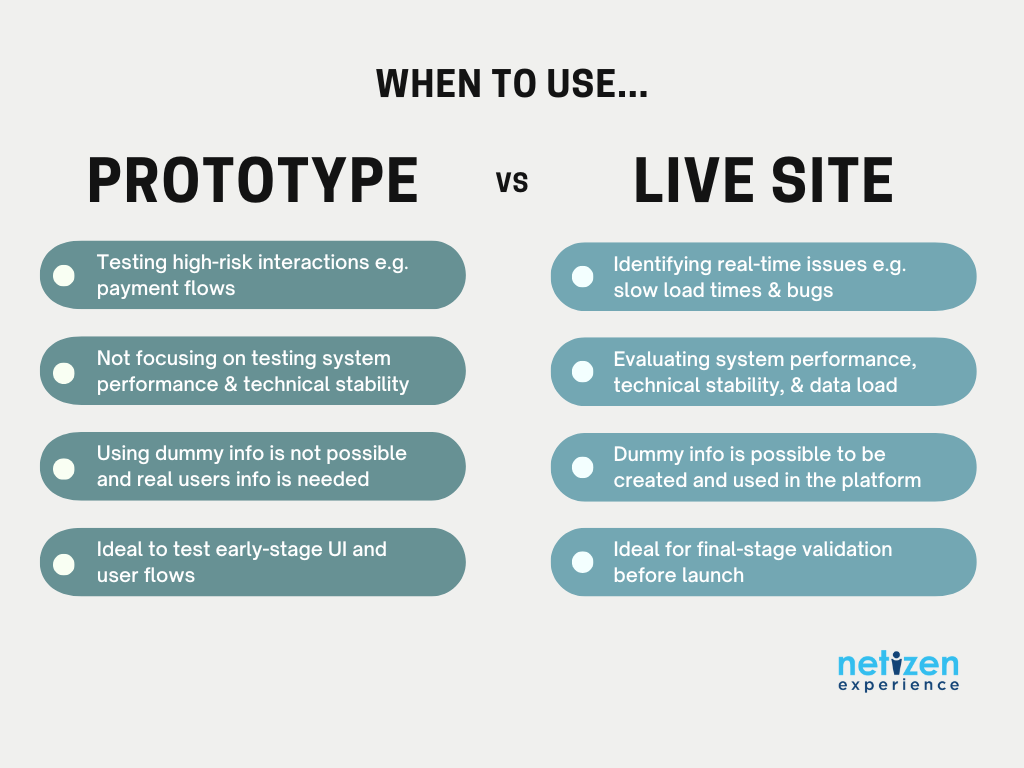The rapid digitalisation across industries has made UX research more critical than ever. Poor usability can lead to serious consequences; whether it’s user frustration or losing revenue and trust in the company. But what happens when research itself becomes the challenge?From balancing data protection and authentic user experience to recruiting the right participants, every step comes with challenges that can shape the success of a study. In this article, we’ll explore the challenges of doing UX research and the strategies to overcome them from our own experience conducting projects as UX researchers.[ez-toc]
Project Planning Challenges
A) Balancing Data Protection and Authentic User Experience
One of the biggest challenges in UX research planning is deciding how to balance authentic user interactions with security and compliance. Some projects require findings which accurately reflect how users would naturally interact with a product, whether that’s using actual systems, real data, or live workflows. But, directly testing sensitive workflows, such as payment flow can expose risk to user data. This dilemma is particularly critical in industries like finance, where strict regulations govern data privacy. The key is choosing the right testing approach: should researchers prioritize realistic interactions with a live system, or opt for the controlled environment of a prototype? Each method has its trade-offs, making it essential to align testing strategies with both research goals and security considerations.
Best practice:
i) To test high-risk interactions, using prototype is recommended for data securityPrototype allows researchers to simulate high-risk interactions safely, ensuring that insights are gathered without violating compliance regulations and using real users' information. For example, testing payment flows which typically involve real transactions and user’s banking credentials. So, using a prototype is particularly beneficial in industries where security and compliance are major concerns such as banking and finance.However, do remember this: A prototype is like a movie set—it looks real, but the walls are just props. While it helps test design and flow, it won’t reveal real-world issues like system performance or technical stability, making insights less accurate compared to live site testing.

Prototype is like a fake movie set, it may look real but it’s not. Bugs and technical issues can’t be replicated in prototype.
ii) To find out users’ perspectives on system performance and technical stability, testing on a live site is necessaryLive site can reveal technical issues such as slow load times, crashes, or bugs that a prototype cannot replicate. However, it also comes with privacy risks since accessing the full functionality of the platform often requires user data. To mitigate this, using dummy information is a must to protect users’ privacy when testing with a live site. This approach ensures data security and allows researchers to observe real user interactions, leading to more actionable insights on engagement, conversion, and pain points that impact the overall user experience.

When choosing between prototype and live site, the complexity of the platform must be carefully considered. The key is to balance the need for security with the depth of insights required, ensuring that UX research delivers meaningful results without compromising compliance.
B) Accommodating for Regional Differences
When companies expand into new markets, they must tailor products to diverse user behaviours, which vary across regions due to differences in technology access, education levels, and income distribution. A one-size-fits-all approach risks making products inaccessible or irrelevant. To create products that align with the local market, UX teams must account for regional factors including economic disparity, language differences, and digital literacy. Economic disparity will influence purchasing power and digital literacy, for example: what's considered a low income in Singapore may be relatively high in Indonesia, Vietnam, or Thailand, which shapes user expectations and affordability. Equally, language plays an essential role in ensuring clarity and cultural relevance. Adapting product content to reflect local languages and terminology not only bridges communication gaps but also fosters trust by aligning with the users’ everyday experiences. Ignoring these differences can result in products that are inaccessible or irrelevant to the target market, leading to low adoption and lost market opportunities. By integrating regional insights from the start, UX teams can build products that are both accessible and relevant to their target users.
Best practice:
i) Following the regional standard is a must
- Understand the target market’s behaviour, cultural differences, and expectations, then tailor your research approach to align with these factors.
- Create user personas that reflect local realities (e.g. income level, age, behaviour), and recruit participants accordingly to ensure alignment with regional demographics and behaviours.
- Consider working with local UX teams to better understand the local culture and language, making insights gained from the target market more accurate and relevant.
Recruitment Challenges
A) Approaching the Participants
“You want me to use an app and share my personal details? Sounds sketchy.”
This is one of the sentences we heard the most when recruiting participants for a study. Convincing people to trust what you are doing is legit can be challenging. No matter how big or reputable your company is, some people remained hesitant to be part of the study. This specifically happens when the target users are older generations.
Best practice:
i) If client does not require anonymity:Send an official invite letter which includes the company logo and contact person to verify the details to show this is not a scam. We found this very helpful specifically for UX research agencies, as participants are more cautious with third-party organisations.

Invite letter with no details (suspicious) vs with company’s details (good)
ii) If client prefers to remain anonymous:In this case, to build trust, we would:
- Have an internal database of trusted testers, this is your best bet. However, if this is not an option, consider reaching out to previous research participants, or team up with a trusted recruitment agency to find the right fit.
- Provide higher incentive to make participation more appealing
- Establish legitimacy by providing the research company’s name and info (e.g. website, LinkedIn, etc).
iii) Establish trust before asking sensitive questions:Building trust helps participants feel comfortable and be honest. To do so, it is important to keep these in mind:
- Build rapport with users before diving into sensitive questions.
- Assure users their data will be kept anonymous and secure.
- Use indirect questioning techniques (e.g., "How do you generally approach investments?" instead of "How much do you invest?") to encourage open responses and make participants feel comfortable while still providing valuable insights.

B) Getting the “Right” Participant
Recruitment can be challenging due to factors like niche user profiles and mismatched expectations between researchers and participants, and one of the biggest challenges is ensuring the participants are the right fit for the study. Ensuring the right fit before the research session helps to prevent disruptions and skewed insights from mismatched participants.
Best practice:
i) Send detailed screening questions:This should be the first steps in the recruitment process to filter out participants who don’t meet the study criteria before moving on to the next step. A detailed screening ensures that only users who truly represent the target audience are selected, as users’ experience level with a product can greatly affect the quality of insights.💡 Pro tip: Instead of simply asking, “Have you used this platform before?” try more specific questions: - "How often do you use this platform?" (Understand usage frequency and experience level). - "Can you describe a recent transaction you made using this platform?" (Measures familiarity and recall).These detailed questions help filter out participants who do not meet the study’s criteria, ensuring that research includes only those who are the right fit for the study. To learn more about screening questions, read our article here.ii) Conduct pre-test session:Pre-test is a brief session to check for potential issues before the actual research session. This helps to identify technical issues including connection problems, software compatibility, or unfamiliarity with research platforms. This step is especially important for remote studies.💡 Pro tip: Keep the session short (5-10 minutes) and use it to confirm user profile & logistics, clarify expectations, and test the participant’s setup.
C) Protecting All Parties Involved
We've all heard the saying "Safety comes first”, and that’s just as true in UX research! Ensuring users feel secure isn’t just a priority; it’s the foundation of getting trust and meaningful insights, as users are less likely to share honest feedback if they feel their data is at risk.
Best practice:
i) Sign NDA (Non-Disclosure Agreement): This helps to reassure participants that their personal information won’t be misused or shared with anyone outside the projects, whilst also protecting confidential company information (e.g. ensuring your new design is not leaked to the public).ii) Use secure data storage and sharing practices: Store all data in secure, encrypted systems with access restricted to authorised personnel only. When sharing reports or findings, always anonymise data to prevent participant identification.
Conclusion
Successful UX research is based on strategic planning, thoughtful participant recruitment, and adaptability to market differences. Balancing data privacy with research goals, aligning with regional user behaviours, and earning participant trust are key to obtaining meaningful insights. Addressing these challenges proactively enables UX teams to create user-centric, accessible, and successful products.





